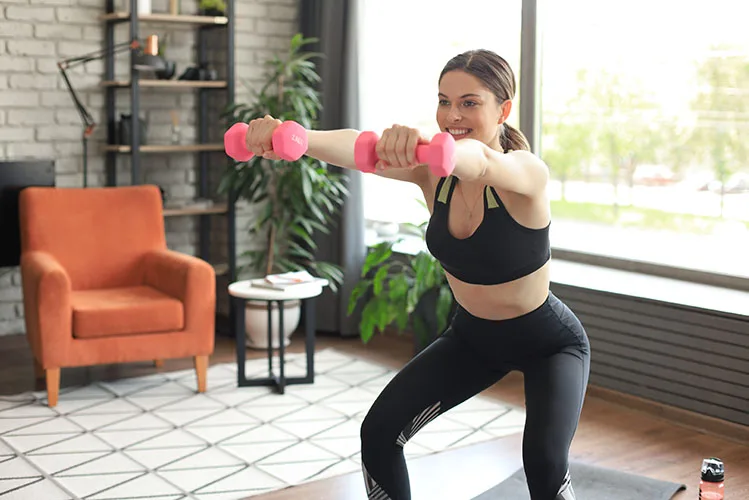Chaos doesn’t have to kill your fitness goals.
The truth is, most people don’t miss workouts because they’re lazy.
They miss them because life takes over.
A late client call runs past dinner.
A traffic jam steals an hour of your evening.
Your child suddenly remembers they need cupcakes for tomorrow’s school party.
Days like these leave even the most motivated person drained.
By bedtime, exercise has been bumped to the bottom of the list.
Again.
But here’s the twist: consistency doesn’t come from having perfect conditions.
It comes from knowing how to adapt.
When your life feels like it’s running at 200 miles an hour, you don’t need a perfect plan.
You need a flexible one.
Let’s walk through how you can keep your fitness alive even when your calendar looks impossible.
Why consistency matters more than intensity
Fitness success isn’t built in dramatic bursts.
It’s built in the small choices you make repeatedly.
A 90-minute workout once a week won’t change your body as much as 15 minutes of movement five times a week.
Why?
Because consistency keeps momentum alive.
Think of it like brushing your teeth.
You wouldn’t skip brushing all week and then scrub for an hour on Sunday.
Your teeth need a little care every day.
Your muscles, heart, and lungs are no different.
I learned this the hard way in my early twenties.
I’d hit the gym for two-hour “monster sessions” on Saturdays because my weekdays were packed.
I thought I was making progress, but I constantly felt sore, burned out, and guilty for missing weekdays.
Then I switched strategies.
Instead of chasing the big Saturday workout, I started doing 15–20 minutes in my living room every weekday morning: bodyweight squats, push-ups, and some stretching.
Within months, I felt stronger and looked leaner than I ever had.
Not because I worked harder, but because I worked consistently.
Reframe what counts as a workout
One of the biggest mindset traps is believing that only an hour at the gym “counts”.
That’s nonsense.
Movement comes in many forms, and every bit adds up.
The people who stay fit long term are the ones who learn to see opportunity where others see obstacles.
Your lunch break? A chance for a brisk 15-minute walk.
Waiting for your coffee to brew? Knock out a set of squats.
Kids watching cartoons? Join them on the floor with stretches.
These “micro-workouts” don’t just burn calories.
They wire your brain to see movement as normal, not optional.
They reinforce your identity as someone who works out, someone who moves no matter how chaotic the day gets.
And once you start seeing yourself that way, skipping workouts becomes harder than doing them.
I once coached a colleague who swore he had no time to exercise.
He commuted, worked 10-hour shifts, and had two young kids.
I challenged him to sneak in five minutes of activity three times a day: stairs at the office, planks before bed, push-ups in the morning.
Six months later, he’d lost 15 pounds.
The kicker?
He never set foot in a gym.
He just redefined what “exercise” meant.
Smart time-blocking in unpredictable schedules
Here’s the uncomfortable truth: if you’re trying to “fit in” workouts, you’ve already lost the battle.
Workouts can’t just fill leftover scraps of time.
They need a slot of their own.
This doesn’t mean a rigid schedule that collapses when one meeting runs late.
It means anchoring workouts to habits you already do without fail.
Do ten minutes of yoga right after brushing your teeth.
Walk the block right after dropping your kids at school.
Start every lunch break with a quick stretch before you eat.
The magic here is reducing decision fatigue.
At the end of a long day, the last thing you want to do is debate whether to work out.
Anchoring your workouts to daily triggers means the decision is already made.
And don’t underestimate early mornings.
I know, the bed is warm.
But mornings are often the only part of the day truly under your control.
Even 15 minutes then can be more reliable than an hour promised “later”.
Ask yourself: where in your day do you have small windows of predictability?
That’s where your workouts belong.
Use environment and tools to your advantage
Willpower fades, but your environment can pick up the slack.
If your sneakers are buried in the closet, you’re less likely to use them.
If your resistance bands are sitting on your desk, you’re more likely to stretch during a call.
Here are a few practical tricks:
- Visible cues: Leave a yoga mat rolled out in the corner. Keep a kettlebell where you can see it. These reminders reduce friction.
- Tools for micro-workouts: A jump rope, resistance bands, or a pull-up bar in a doorway can turn 5 spare minutes into training.
- Tech helpers: Apps that offer 7- or 10-minute workouts are perfect for busy schedules. They eliminate planning, which means you just hit start and go.
I once left a kettlebell in my living room.
It looked a little odd, sitting by the couch, but every time I saw it, I’d do a few lifts.
Over a year, those “incidental lifts” added up to a measurable strength boost.
Small cues, repeated often, become powerful habits.
Build accountability without pressure
Let’s be honest: when life gets hectic, self-discipline isn’t always enough.
That’s where accountability steps in.
Humans are wired to follow through when others are watching.
This doesn’t have to mean an intimidating personal trainer.
It could be:
- A workout buddy who texts you when you don’t show
- A challenge group where you log your progress
- An app that celebrates your streak (you won’t want to break it)
Years ago, I joined a “push-up challenge” with coworkers.
We each had to send a photo of our daily push-ups to the group chat.
On busy days, I would’ve skipped, but knowing they were waiting kept me honest.
Accountability doesn’t just keep you consistent.
It makes workouts more fun.
So ask yourself: who or what can you tie your accountability to when chaos hits?
Shift mindset from perfection to progress
Perfection is seductive, but it’s poison for consistency.
The voice in your head whispers: “If I can’t do a full workout, I shouldn’t bother“.
That’s the fast track to quitting.
Here’s the truth: something is always better than nothing.
Ten minutes is better than zero.
A walk around the block is better than collapsing into the couch.
These “small wins” keep the chain alive, and that chain of consistency is what transforms your body and mind.
I can’t count how many people I’ve seen abandon fitness chasing a “perfect plan”.
The people who stick with it?
They accept imperfection.
They train in hotel rooms, they stretch in airports, they knock out push-ups in kitchens.
They keep showing up, messy and inconsistent, but never stopped entirely.
That’s the real secret.
And remember: exercise isn’t punishment.
It’s a gift you give yourself.
On chaotic days, it can be the one steady anchor that keeps you sane.
By shifting your mindset, reframing what counts as a workout, anchoring exercise into your day, using your environment as an ally, and building accountability, you can build a workout habit that thrives even in the busiest seasons.
Now here’s your challenge: pick one tactic and use it today.
Not tomorrow.
Not “when things calm down”.
Today.
Do a five-minute walk, ten push-ups, or a quick stretch.
Then protect that streak like gold.
Because fitness isn’t built on perfect schedules.
It’s built on consistency through the chaos.
Tags: workout consistency, busy day fitness tips, how to exercise with a busy schedule, short workouts for busy people, quick workout hacks, time management for fitness, micro workouts at home, workout accountability ideas, consistency over intensity fitness, DL004






